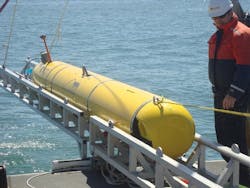Navy picks General Dynamics for unmanned underwater vehicles (UUVs), upgrades to SATCOM and sensor payloads
WASHINGTON – U.S. unmanned underwater vehicle (UUV) experts needed a company to upgrade the 21-inch-diameter Black Pearl UUV with new capabilities such as satellite communications (SATCOM) capability. They found their solution from the General Dynamics Corp. Mission Systems segment in Quincy, Mass.
Officials of the Naval Research Laboratory (NRL) in Washington announced a $20.9 million contract last week to General Dynamics to upgrade the Navy's fleet of UUVs to accommodate new sensor payloads, and build new UUVs to support future research missions.
The contract calls for General Dynamics to provide five new Black Pearl UAVs; two side-scan sonars; upgraded tail and nose sections, and spare parts. The Black Pearl UUV supports Navy research programs in anti-submarine warfare (ASW) and mine countermeasures.
The contract asks General Dynamics to provide two-way Iridium SATCOM to the Black Pearl UUV; alter the unmanned submersible's payloads bay; determine the best way to accommodate side-scan and multi-beam sonar; and manufacture new UUVs and control systems, tail sections, and batteries.
The five new Black Pearl UUVs include tail sections for each of the Black Pearl UUVs; a battery power section for each UUV; and a nose section for each UUV.
General Dynamics is the original manufacturer of the Black Pearl. The company won a $7.1 million contract in April 2014 design and build the Black Pearl underwater drone for research in long range and multi-static mine hunting and ASW programs, as well as in new distributed sensing research. Bluefin experts were to build as many as five next-generation underwater drones based on the company's Bluefin 21 UUV.
General Dynamics also will provide a new software driver for the Black Pearl's Iridium board, develop software to enable basic two-way messaging, software to help upload missions to the UUV via Iridium, and software drivers and mechanical structures to accommodate Navy research payloads in the payload sections.
The company also will provide topside UUV-operator equipment that includes two RF deck boxes with antennas; two Iridium deck box with antennas; one Sonardyne Dunker kit; two RDF receivers and antennas; five battery chargers; two sets of vehicle carts; two vehicle shipping cases; one vehicle tool kit; and two ruggedized operator laptop computers with operator software.
The original Black Pearl design has a 3-to-5-nautical-mile per hour operating speed, a 400 meter depth capability, a minimum of 18 kilowatt-hour energy storage, and a real-time GPS-aided fiber optic gyro (IXSEA PHINS III), inertial navigation system (INS) integrated with Doppler velocity log instrument capable of measuring the vehicle's horizontal position, velocity, and attitude.
The position accuracy drift rate while traveling submerged on a straight line, is 0.15 percent of distance traveled, or less. The system has an over-the-horizon (OTH) communication capability for periodic vehicle status, monitoring, and redirection using Iridium SATCOM system while the vehicle is on the surface.
The UUV supports several payload types, supplied by NRL researchers, that may include broadband low frequency sonars for MCM and ASW; environmental data sensors such as water depth, speed of sound in water along vehicle path, water temperature, and water current); and payloads for acoustic modem research (ACOMMS).
It can carry several sensors and payloads at once in swappable payload sections and battery modules for in-field mission reconfiguration. The UUV is a deep-rated ocean drone that can be launched and recovered from a simple A-frame or docking head.
The Bluefin 21 design is 16.2 feet long, 21 inches in diameter, and weighs 1,650 pounds. It can dive to nearly 15,000 feet, can operate for 25 hours on one battery charge, and moves at speeds to 4.5 knots while using a total of 13.5 kilowatts of electricity.
The UUV is a popular vehicle for deep-dive research and counter-mine operations. The UUV is the basis for the Navy General Dynamics Knifefish surface-mine countermeasure unmanned underwater vehicle (UUV).
For more information contact General Dynamics Mission Systems online at https://gdmissionsystems.com, or the Naval Research Laboratory at www.nrl.navy.mil.
About the Author
John Keller
Editor-in-Chief
John Keller is the Editor-in-Chief, Military & Aerospace Electronics Magazine--provides extensive coverage and analysis of enabling electronics and optoelectronic technologies in military, space and commercial aviation applications. John has been a member of the Military & Aerospace Electronics staff since 1989 and chief editor since 1995.
